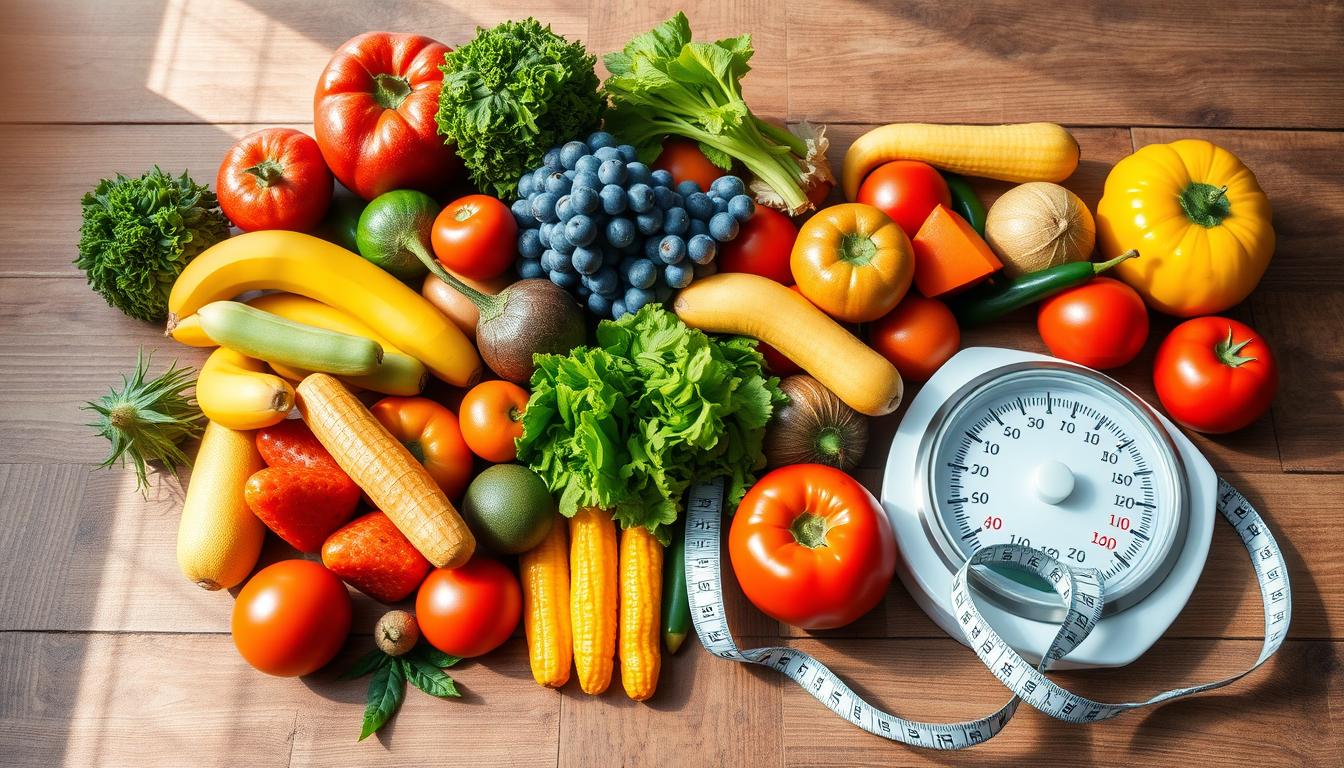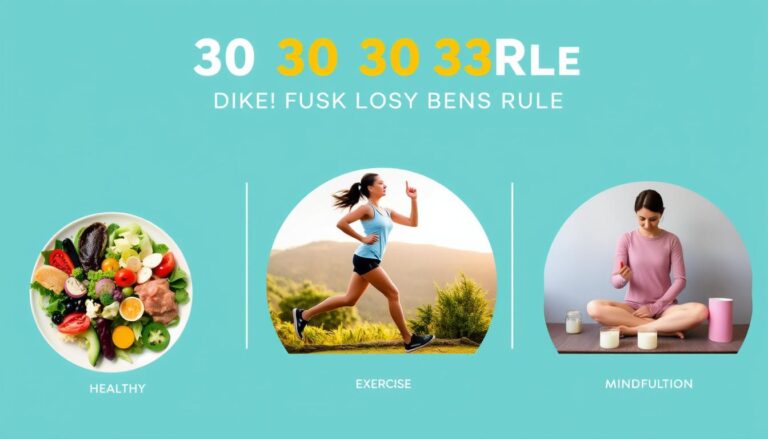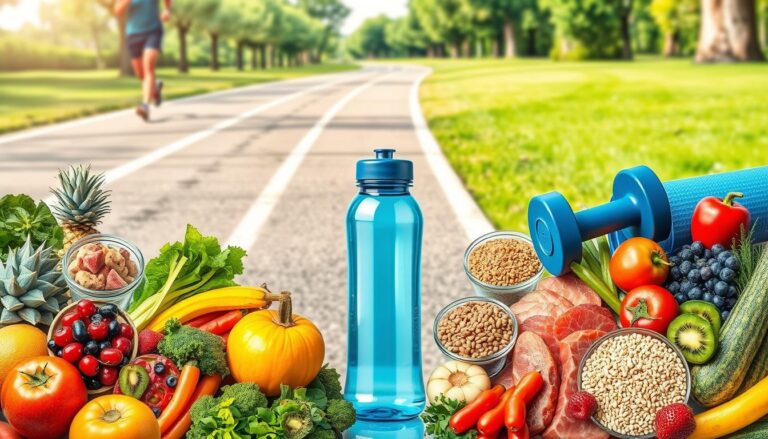Obesity is a big health problem worldwide. We all want to lose weight and live healthier. There are many diets out there, like low-carb and intermittent fasting. I want to help you find a diet that works for you.
Choosing a diet isn’t just about what’s popular. It’s about finding one that fits your health needs and has science backing it. Losing weight is a personal journey. What works for one might not work for another. So, it’s important to understand the basics of different diets.
Key Takeaways
- Finding the right diet is essential for healthy weight reduction.
- Various weight loss diets cater to different lifestyles and preferences.
- Scientific evidence should guide your decision-making process.
- Effective weight loss is highly individualized.
- A personalized approach ensures better long-term results.
Introduction to Weight Loss Diets
Dieting for weight loss is key for those wanting to lose extra pounds. The main goal is to eat fewer calories than your body burns. This helps your body use stored fat for energy. You can do this by changing what you eat, controlling portion sizes, or following certain diets.
There are many diets out there, like the ketogenic diet, intermittent fasting, and plant-based diets. Each has its own way of helping you lose weight. Some cut down on carbs, while others focus on eating more protein or changing when you eat. These diets try to fit different lifestyles and preferences.
Picking a diet that fits your life and goals is important. For example, eating whole foods and balanced nutrients helps with workouts. Whether you work out at home or the gym (learn more about workout places).
Now, let’s look at some diets we’ll explore more:
| Diet | Core Philosophy | Suitable For |
|---|---|---|
| Ketogenic | Low-carb, high-fat, carb-burning | Individuals targeting rapid fat loss |
| Intermittent Fasting | Cycles of eating and fasting | Those preferring flexible meal schedules |
| Plant-Based | Diet rich in vegetables, fruits, legumes | People focusing on nutrient-dense foods |
Effective dieting is more than just cutting calories. It’s about finding a balance that leads to a healthier life. Let’s explore these diets to find the best one for you!
Understanding Calorie Deficit
To lose weight, knowing about calorie deficit is key. It happens when you eat less than your body burns. This makes your body use fat for energy. It’s a main part of losing weight.
What is a Calorie Deficit?
A calorie deficit means you burn more calories than you eat. This makes your body use fat for energy.
How to Calculate Your Caloric Needs
Finding out how many calories you need is important. Your age, sex, weight, height, and how active you are affect this.
- Age: Younger people need more calories.
- Sex: Men usually need more calories than women because of more muscle.
- Weight: Heavier people need more calories to stay the same weight.
- Height: Taller people need more calories.
- Activity Level: Being active means you need more energy.
Using formulas like the Harris-Benedict or online tools can help. They give you a good starting point for how many calories you should eat each day.
Common Mistakes in Calorie Counting
Counting calories right is key for a calorie deficit. But, people often make mistakes:
- Underestimating Portion Sizes: Thinking you’re eating less than you are can lead to eating more calories.
- Overlooking ‘Hidden’ Calories: Drinks, sauces, and snacks have calories that add up but are often ignored.
- Inconsistent Tracking: Not logging every meal, snack, or drink can mess up your calorie counting.
To avoid these mistakes, use good tools and track your food consistently. This helps you stay on track with your calorie deficit goals.
The Role of Macronutrient Ratios
Learning about macronutrients like proteins, carbs, and fats is key. They help you make smart food choices. Finding the right balance is important for losing weight.
Proteins, Carbs, and Fats Explained
Proteins help fix and grow muscles. Eating more protein can make you feel full. Carbs give you energy, but cutting down on them can help with weight loss. Fats are important for healthy fats and vitamins.
Finding Your Ideal Macronutrient Ratio
Finding the right mix of macronutrients is personal. It depends on your goals, how active you are, and your health. A good mix is usually 40-50% carbs, 20-30% proteins, and 25-35% fats.
| Macronutrient | Recommended Percentage | Role in Diet |
|---|---|---|
| Carbohydrates | 40-50% | Primary energy source |
| Proteins | 20-30% | Muscle repair and growth |
| Fats | 25-35% | Essential fatty acids and vitamin absorption |
Balancing Macronutrients for Weight Loss
Getting the right balance of macronutrients helps with weight loss. Eat more protein and cut carbs to keep energy up without too many calories. Watch your intake and adjust as needed. This way, you get all the nutrients you need and manage your weight well.
Which Diet is the Most Effective in Weight Loss?
Choosing the right diet is key for effective weight loss. Different diets work for different people. Diets like intermittent fasting, Mediterranean, DASH, low-carb, and paleo have shown success in weight loss.
Looking at both short-term and long-term results is important. Low-carb diets can lead to quick weight loss but may not last. The Mediterranean diet, however, is known for its balance and long-term health benefits. It’s one of the proven diets for weight loss.
Adapting to a diet is also crucial. A diet that fits your lifestyle and food likes is easier to stick to. For example, some find intermittent fasting easier and more effective for weight loss.
There’s no single diet that works for everyone. It’s important to pick a diet that’s healthy, easy to follow, and meets your goals. Always talk to a healthcare professional before starting any diet to make sure it’s safe and right for you.
The Basic Principles of Intermittent Fasting
Intermittent fasting is a way to eat that switches between eating and fasting. It doesn’t tell you what to eat, but when. It breaks the usual three meals a day pattern, adding a new rhythm to our eating.
What is Intermittent Fasting?
Intermittent fasting means you alternate between eating and fasting. It’s flexible, letting you pick a schedule that works for you. It’s not about starving, but giving your body a break from always digesting.
Popular Intermittent Fasting Methods
Many fasting methods are popular because they’re easy and work well:
- 16/8 Method: Fast for 16 hours and eat in an 8-hour window. This often means skipping breakfast and eating two or three meals later.
- 5:2 Diet: Eat normally for five days and eat very little (500-600 calories) on the other two days.
- Eat-Stop-Eat: Fast for 24 hours once or twice a week, then eat normally.
Benefits and Drawbacks of Intermittent Fasting
Intermittent fasting has many benefits. It can improve your metabolic health, make you more sensitive to insulin, and even help you live longer. It makes it easier to control calories without counting them.
But, it’s not perfect. You might feel hungry, irritable, or like you’re missing out, especially at first. It can also be hard when you’re out with friends or at meals that don’t fit your schedule.
In short, picking the right fasting method can lead to a healthier life. But, think about the good and bad sides to see if it’s right for you.
The Science Behind Low-Carb Diets
Low-carb diets work by cutting down on carbs. This makes the body use fat for energy instead of carbs. It’s a way to lose weight by burning fat.

How Low-Carb Diets Work
These diets lower insulin levels. This helps burn fat better. By eating less carbs and more protein and fat, the body uses fat for energy.
This change leads to steady weight loss and more energy. It also helps control blood sugar.
Types of Low-Carb Diets
There are many low-carb diets. Each has its own level of carb restriction:
- Atkins Diet: It’s low in carbs, high in protein and fat. It has phases to add carbs back in.
- Ketogenic Diet: It’s very low in carbs and high in fat. It makes the body burn fat for energy.
- Paleo Diet: It focuses on whole foods, lean proteins, and fruits and nuts. It’s like eating like ancient humans.
Potential Benefits and Risks
Studies show low-carb diets have many benefits. They can improve blood sugar, reduce hunger, and boost mental clarity. But, they can also lead to nutrient deficiencies if not balanced.
It’s wise to talk to a doctor before starting. They can help make sure it’s safe and effective for you.
| Diet Type | Main Features | Potential Benefits | Potential Risks |
|---|---|---|---|
| Atkins | Low-carb, high-protein, high-fat | Weight loss, better blood sugar control | Nutrient deficiencies |
| Ketogenic | Very low-carb, high-fat | Faster weight loss, mental clarity | Keto flu, nutrient deficiencies |
| Paleo | Whole foods, lean proteins, no processed foods | Better digestion, weight management | Restrictive, may lack certain nutrients |
Introduction to the Ketogenic Diet
The ketogenic diet is all about eating lots of fat, some protein, and very few carbs. It helps you lose weight. By cutting down carbs and eating more fat, your body starts burning fat for energy instead of sugar.
What is the Ketogenic Diet?
This diet focuses on foods high in healthy fats like avocados, nuts, and seeds. It also includes moderate amounts of protein from fish, poultry, and eggs. Carbs are kept low, around 50 grams a day, mainly from veggies.
This change helps your body make ketones. Ketones are better for your brain and muscles than sugar.
How to Get Started with Keto
Starting keto might seem hard, but it’s easier with a few steps:
- Plan your meals ahead to make sure they fit the keto diet.
- Add foods high in fat like olive oil, coconut oil, and butter.
- Eat leafy greens and low-carb veggies for fiber.
- Drink plenty of water and think about taking electrolyte supplements to avoid early problems.
Common Challenges and Solutions
Keto can have its tough spots, but you can get past them:
- Keto Flu: This is a short-term issue with headaches, tiredness, and mood swings from not eating carbs. Drink more water and eat more salt to fight it.
- Social Dining: Eating out can be hard, but choose grilled meats, salads with fatty dressings, and skip the bread. It helps you stay on keto.
- Variety: Don’t get bored with the same old foods. Try new recipes and add different keto-friendly foods and spices to keep things interesting.
Learning about the ketogenic diet and how to handle early challenges makes starting keto a good choice.
Plant-Based Diets for Weight Loss
Plant-based diets for weight loss focus on whole foods. These include vegetables, fruits, legumes, nuts, and seeds. They are the base of our meals.
The Basics of a Plant-Based Diet
A plant-based diet avoids processed foods. It focuses on whole grains, fresh produce, and legumes. These foods support health and the planet.
Health Benefits of Plant-Based Diets
Vegetarian diets offer many health benefits. They can lower the risk of heart disease, diabetes, and high blood pressure. They also improve digestion and boost energy.
Plant-Based Diets and Weight Loss
Many choose vegan weight loss for its benefits. Plant-based foods are high in fiber, which helps control hunger. They are also low in calories, aiding in weight management.
| Diet Component | Benefits | Examples |
|---|---|---|
| Fruits and Vegetables | High in vitamins and minerals | Apples, spinach, carrots |
| Whole Grains | Rich in fiber and nutrients | Quinoa, brown rice, oats |
| Legumes and Nuts | Excellent protein sources | Chickpeas, lentils, almonds |
Importance of Diet Sustainability
Starting a weight loss journey means adopting sustainable dieting. This method focuses on making diet changes that are realistic, fun, and fit your lifestyle. It’s key to stick to your diet for the long haul, which is why long-term adherence is so important.
A sustainable diet isn’t just for quick weight loss. It’s about making a lifestyle change for lasting health. Abdullaah Yaseen, a former football player, turned to blogging. He shows how to enjoy your favorite foods while staying fit. Visit his blog to learn more.
“The secret to lasting weight loss lies in making changes that fit into your daily life effortlessly. It’s about small, attainable goals and enjoying the process while improving your health,” says Yaseen.
Healthy changes are key for sustainable dieting. It’s about finding a balance with foods you love and can keep up with. A flexible approach helps you lose weight and enjoy a healthier relationship with food.
| Key Aspects | Sustainable Dieting | Short-Term Diets |
|---|---|---|
| Focus | Long-term adherence | Quick results |
| Flexibility | High | Low |
| Enjoyment | Integrated | Often restricted |
| Results | Gradual and lasting | Rapid but temporary |
By focusing on long-term adherence through sustainable dieting, you’re setting yourself up for success. The best diet is one that helps you lose weight and becomes a lasting part of your life.
Long-Term Weight Management Strategies
To keep weight off, you need more than just losing it. You must adopt lasting, healthy habits. These habits help you stay at your goal weight and get past weight loss plateaus.
Maintaining Weight Loss
After losing weight, keeping it off is key. Regular exercise is a must. It burns calories and keeps your metabolism up.
Watching what you eat is also vital. By paying attention to your diet, you can make choices that help you stay on track.
Building Healthy Habits
Keeping weight off means building healthy habits. Use science to set goals that are clear and achievable. Eat well, exercise, sleep enough, and manage stress.
These habits help you stay healthy and keep your weight in check. They also make you feel better overall.
Overcoming Weight Plateaus
A weight loss plateau can be tough, but it’s normal. It means your body has adjusted to your routine. To get past it, try new exercises, change your diet, or try fasting.
Stay patient and keep trying. Remember, plateaus are short-lived and can be overcome with the right strategy.
| Strategy | Benefits |
|---|---|
| Regular Physical Activity | Supports weight maintenance, boosts metabolism, maintains muscle mass |
| Ongoing Dietary Monitoring | Helps avoid weight regain, promotes informed eating choices |
| Setting SMART Goals | Guides healthy habit formation, enhances motivation |
| Varying Exercise Routine | Breaks through weight plateaus, prevents adaptation |
| Intermittent Fasting | Potential tool for overcoming plateaus, supports metabolic flexibility |
Tips for Staying Motivated
Staying motivated on a weight loss journey is tough, but it’s key to success. A good strategy is to set clear, reachable goals. Instead of aiming for a big goal, break it down into smaller steps. For example, aim to lose five pounds at a time, not 50.
“Setting small, realistic goals can help you build momentum and keep your motivation high,” says personal trainer Jillian Michaels.
Tracking your progress is also important. Use a journal or app to log your food and workouts. This shows you’re making progress. Celebrate these small wins by rewarding yourself with something other than food, like a new workout outfit.
Having someone to be accountable to is crucial. Share your goals with a friend or join a weight loss group. This makes your journey less lonely. Even posting your goals on social media can help you stay committed. Healthline says having a strong support network helps you succeed more.
Lastly, be kind to yourself. Everyone has setbacks, but how you handle them matters. Don’t be too hard on yourself when you slip up. Use these moments to learn and grow. Being resilient helps you stay motivated and move closer to a healthier you.
| Strategies | Benefits |
|---|---|
| Goal Setting | Creates manageable steps and builds momentum |
| Progress Tracking | Provides a tangible sense of achievement |
| Accountability | Establishes a support network and increases commitment |
| Self-Compassion | Enhances resilience and learning from setbacks |
Conclusion
Exploring different diets shows that finding the right one is very personal. Each person’s health journey is unique. It depends on their goals, lifestyle, and what they like.
There’s no single diet that fits everyone. What works for one person might not work for another. It’s important to find what works best for you.
Choosing a diet should be based on science, not just trends. It should help you reach your health goals. Remember, keeping weight off is about making lasting changes, not quick fixes.
Now, you’re ready to make better choices for your health. Focus on building good habits and staying motivated. Success comes from being consistent and never giving up. Here’s to a healthier, happier you!
FAQ
What is a calorie deficit?
A calorie deficit means you eat fewer calories than your body needs. This makes your body use stored fat for energy. You lose weight as a result.
How can I calculate my calorie needs?
Use the Mifflin-St Jeor equation or online calculators to find your calorie needs. These tools consider your age, sex, weight, height, and activity level.
What are common mistakes in calorie counting?
Mistakes include underestimating food portions and forgetting about hidden calories in drinks and sauces. Also, measuring food incorrectly can lead to errors.
What are macronutrients, and why are they important?
Macronutrients are energy-providing nutrients like proteins, carbs, and fats. They’re crucial for body functions. Balancing them is key for health and weight loss.
How do I find my ideal macronutrient ratio?
Your ideal ratio depends on your health goals, activity level, and preferences. Aim for a balance of carbs, proteins, and fats for effective weight loss.
What is intermittent fasting?
Intermittent fasting alternates between eating and fasting periods. Popular methods include the 16/8 method and the 5:2 diet.
Are there benefits to intermittent fasting?
Yes, it can improve metabolic health, aid in weight loss, and enhance insulin sensitivity. However, it may cause hunger and make social eating harder.
What is a low-carb diet, and how does it work?
Low-carb diets limit carbs to promote weight loss and better health. They make your body burn fat for energy, leading to weight loss and better blood sugar control.
What are the potential benefits and risks of low-carb diets?
Benefits include weight loss and better blood sugar levels. However, risks include nutrient deficiencies and the difficulty of sticking to it long term.
What is the ketogenic diet?
The ketogenic diet is high in fat, moderate in protein, and low in carbs. It puts your body into ketosis, where it burns fat for energy.
How do I start a ketogenic diet?
Start by cutting carbs to 20-50 grams a day. Increase fat intake and eat moderate protein. Focus on keto-friendly foods like meats, eggs, and low-carb veggies.
What are the basics of a plant-based diet?
A plant-based diet focuses on whole, plant-based foods like veggies, fruits, nuts, and whole grains. It often excludes or limits animal products.
What are the health benefits of a plant-based diet?
Plant-based diets can lower risks of heart disease, type 2 diabetes, and some cancers. They can also help with weight management.
How is diet sustainability important for weight loss?
Sustainable diets help you stick to healthy eating long term. They should be enjoyable, realistic, and fit your lifestyle and values.
How can I maintain weight loss in the long term?
Keep eating healthy, stay active, and watch your weight. Building lasting healthy habits is crucial to avoid regaining weight.
What should I do if I hit a weight loss plateau?
If you hit a plateau, try adjusting your diet or increasing exercise. Sometimes, small changes can help break through.
How can I stay motivated on my weight loss journey?
Stay motivated by setting achievable goals, tracking your progress, and creating a supportive environment. Celebrate small wins and be kind to yourself when faced with setbacks.





